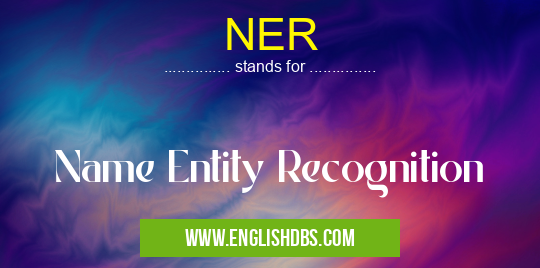What does NER mean in UNCLASSIFIED
NER stands for Name Entity Recognition. It is a subfield of natural language processing (NLP) that involves identifying and classifying named entities in unstructured text. Named entities are specific types of real-world objects, such as people, organizations, locations, dates, and amounts.

NER meaning in Unclassified in Miscellaneous
NER mostly used in an acronym Unclassified in Category Miscellaneous that means Name Entity Recognition
Shorthand: NER,
Full Form: Name Entity Recognition
For more information of "Name Entity Recognition", see the section below.
How NER Works
NER systems typically use machine learning models to identify and classify named entities. These models are trained on large datasets of annotated text, where each named entity is labeled with its corresponding type. The models learn to recognize patterns and features in the text that are indicative of named entities.
Applications of NER
NER has numerous applications in various domains, including:
- Information Extraction: Extracting structured data from unstructured text, such as news articles and social media posts.
- Search and Retrieval: Improving search results by recognizing named entities and their relationships.
- Machine Translation: Identifying named entities to ensure accurate translation.
- Spam Filtering: Detecting spam emails by recognizing named entities that are commonly used in phishing attempts.
Essential Questions and Answers on Name Entity Recognition in "MISCELLANEOUS»UNFILED"
What is Named Entity Recognition (NER)?
Named Entity Recognition (NER) is a subtask of Natural Language Processing (NLP) that identifies and classifies named entities within a text. Named entities can be people, places, organizations, dates, times, quantities, monetary values, and other specific categories.
Why is NER important?
NER is crucial because it helps machines understand the meaning and context of text data. It enables various downstream applications, such as:
- Information extraction and retrieval
- Question answering systems
- Machine translation
- Summarization and text mining
What are the common NER techniques?
Common NER techniques include:
- Rule-based methods: Use predefined rules to identify named entities.
- Machine learning methods: Train models on annotated data to classify entities.
- Gazetteer-based methods: Match named entities against a predefined list of known entities.
- Hybrid methods: Combine different techniques to improve accuracy.
What are the challenges in NER?
Challenges in NER include:
- Entity ambiguity: Different entities can have the same name or vice versa.
- Contextual dependence: Entities can be identified differently depending on the context.
- Nested entities: Entities can be nested within other entities.
- Unknown entities: NER systems may not identify entities that are not included in their knowledge base.
How is NER evaluated?
NER systems are typically evaluated using metrics like:
- Precision: Proportion of identified entities that are correct.
- Recall: Proportion of correct entities that are identified.
- F1-score: Harmonic mean of precision and recall.
Final Words: NER is a crucial technology in NLP that enables the identification and classification of named entities in unstructured text. It has a wide range of applications, from information extraction to machine translation. As NLP continues to advance, NER will play an increasingly important role in unlocking the value of unstructured data.
